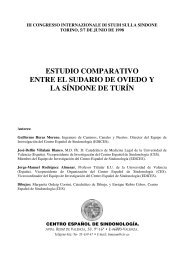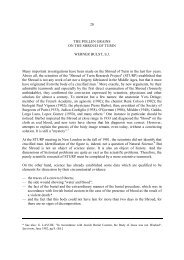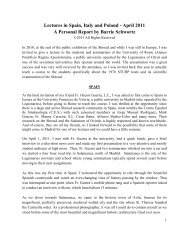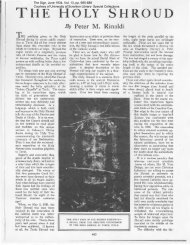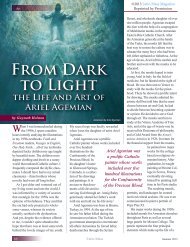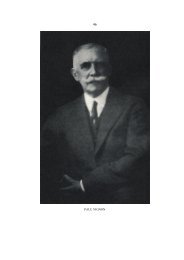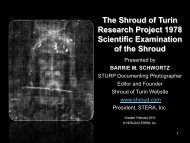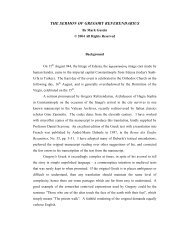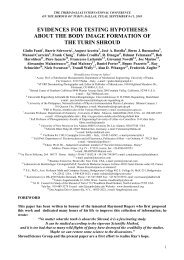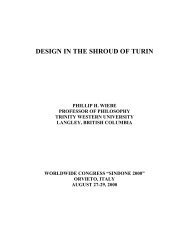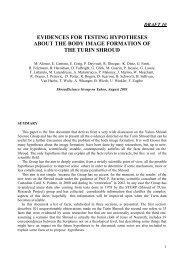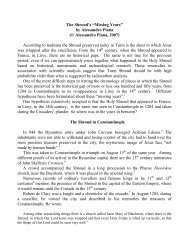BSTS Newsletter No. 52 - Part 6 - The Shroud of Turin Website
BSTS Newsletter No. 52 - Part 6 - The Shroud of Turin Website
BSTS Newsletter No. 52 - Part 6 - The Shroud of Turin Website
Create successful ePaper yourself
Turn your PDF publications into a flip-book with our unique Google optimized e-Paper software.
Letters to the Editor<br />
An electrically charged <strong>Shroud</strong><br />
From Dr. John Jackson <strong>of</strong> the <strong>Turin</strong> <strong>Shroud</strong> Center, Colorado<br />
I feel some comments are needed on Tony Fleming's article 'Could carbon dating be<br />
erroneous if the <strong>Shroud</strong> was kept in a metallic container for a significant period between<br />
AD30-2000' as published in <strong>Newsletter</strong> <strong>No</strong>.51.<br />
<strong>The</strong> hypothesis that charge build-up within a closed metal environment will retard or even<br />
halt radioactive decay from the nucleus assumes that this charge will remain trapped within<br />
the closed system indefinitely. Common experience says that this will simply not happen<br />
(e.g. batteries discharge, etc.) Nature does not want to remain in a condition <strong>of</strong> charge<br />
separation and wants to seek electrical neutrality.<br />
<strong>The</strong>re are many electrical pathways that permit this to occur. For example, air has an intrinsic<br />
electrical conductivity. This will allow any charges, initially separated by radioactive decay,<br />
to achieve charge neutrality within the box by electrical currents through the air. When a C-<br />
14 decay occurs, the carbon nucleus is converted to N-14 (nitrogen), while its electron cloud<br />
is still that <strong>of</strong> carbon. This situation remains only for a moment and the electron cloud<br />
quickly finds the needed electron from its surroundings to cause neutralization <strong>of</strong> the atom.<br />
<strong>No</strong>w suppose that a D.C. electric field is present (the author assumes this is due to many<br />
radiocarbon decays). It is likely that the electron cloud surrounding the C-14 nucleus will<br />
readjust itself so as to repel the D.C. field away from the nucleus. This is what happens<br />
when a charge is placed upon an electric conductor, like metal. <strong>The</strong> charges rearrange<br />
themselves on an equipotential surface. <strong>The</strong> result is that the electric field inside the<br />
conductor is absolutely zero. This phenomenon is well-known in any elementary course in<br />
electrostatics.<br />
A common assumption in the theory <strong>of</strong> chemical bonding, called the Born-Oppenheimer<br />
approximation, is that electrons adjust themselves within the atom on a time scale much<br />
shorter than those <strong>of</strong> atomic motions. Accordingly, I think that electrons surrounding the<br />
nucleus, when subjected to a static electric field, will quickly arrange themselves so as to<br />
counter that field and thereby repel it from the nucleus. It is well-known that molecules can<br />
become polarized when placed in an electric field and this is due to electronic readjustments.<br />
In addition, electric fields are known to cause shifts and splitting in atomic spectra, which is<br />
due to electronic rearrangements. Accordingly, I think that a nucleus will be protected by its<br />
own electronic cloud from any exterior electrostatic fields.<br />
In fact, if Mr.Fleming's hypothesis is correct, then we would have solved the problem <strong>of</strong><br />
radioactive waste. All we have to do is to seal the waste in a metallic chamber, electric fields<br />
would build by radioactive decay, and the dangerous decay process would stop. I know <strong>of</strong> no<br />
Los Alamos type studies that suggest this happens, and it will not happen because leakage<br />
currents will unavoidably dissipate charge into the external environment (as it would for the<br />
<strong>Shroud</strong>). Finally, if electrostatic charges were to build as envisioned by the author, on the<br />
order <strong>of</strong> several tens <strong>of</strong> kilovolts according to my calculations, it would be like opening the<br />
power supply on a television set, something that could be fatal.<br />
Dr. John Jackson, <strong>Turin</strong> <strong>Shroud</strong> Center <strong>of</strong> Colorado,<br />
P.O.Box 25326, Colorado Springs, CO 80918, USA
<strong>Shroud</strong> Facial Markings on a 12 th century coin<br />
From Paul Michelet <strong>of</strong> Perth, Australia<br />
While recently perusing a book on coins I became intrigued by a silver ducat from the reign<br />
<strong>of</strong> Roger II, king <strong>of</strong> Sicily 1130-1154. It is a copy <strong>of</strong> a Byzantine coin and shows an image <strong>of</strong><br />
Christ on one side and king Roger and his son on the other. <strong>The</strong> Christ image clearly shows<br />
the 'V' marking on the forehead, as visible on the <strong>Shroud</strong>. <strong>The</strong> book in question is Byzantine<br />
Coins by Dr.P.D.Whitting (Barrie & Jenkins 1973), and its illustrations include a number <strong>of</strong><br />
Byzantine coins bearing images <strong>of</strong> Jesus, also the Virgin Mary. Roger II was an interesting<br />
character who seemed to straddle the worlds <strong>of</strong> East and West. Between 1061 and 1091 his<br />
father Roger I captured Calabria and Corfu from the Byzantines and Sicily from the Muslims.<br />
<strong>The</strong> Encyclopaedia Britannica (Micropaedia vol X, p.136, 1992 ed.) has a nice illustration <strong>of</strong><br />
Roger II being crowned by a three-quarter face Christ <strong>of</strong> the 'Pantocrator' type, and dressed in<br />
Byzantine fashion. I am aware that one can easily read too much into a detail like this, but<br />
hope you find it <strong>of</strong> some interest.<br />
Paul Michelet, Unit 10, 34 Palmerston St., <strong>No</strong>rthbridge,<br />
Perth, Western Australia 6003<br />
<strong>Shroud</strong> Facial Markings on a 13 th century French Sculpture<br />
From Peter Leitch, <strong>of</strong> Dunmurry, Belfast;<br />
I would like to draw your attention to the Christ on the great Tympanum over the west door <strong>of</strong><br />
St. Etienne Cathedral, Bourges, France. <strong>The</strong> date <strong>of</strong> construction <strong>of</strong> Bourges Cathedral is<br />
1192-1275 AD which puts the Tympanum, if contemporary with the building <strong>of</strong> the<br />
Cathedral, outside the mean <strong>of</strong> the radiocarbon date 1260-1390. On seeing this image I was<br />
immediately struck by the resemblances <strong>of</strong> facial features that the Tympanum Christ shares<br />
with the man <strong>of</strong> the <strong>Shroud</strong>. To me at least it is glaringly obvious that Christ's face as<br />
portrayed on the Tympanum was copied from the <strong>Shroud</strong>, given again contemporaneity with<br />
the Cathedral.<br />
Of all the faces on the carved stone none has the acute attention to detail as does that <strong>of</strong><br />
Christ. <strong>The</strong> representation <strong>of</strong> damage to the eyes is more than a little impressive and the<br />
sculptor has obviously taken time to get this right. Look too at the hair, beard and moustache<br />
- all unmistakably <strong>Shroud</strong>-like. That peculiar little quiff <strong>of</strong> hair which falls down over the
forehead from the centre parting is also present and this we know to be quite possibly<br />
expressive <strong>of</strong> the figure 3 bloodstain observable on the <strong>Shroud</strong><br />
Peter Leitch, 17 Church Avenue, Dunmurry<br />
Belfast, <strong>No</strong>rthern Ireland BT17 9RS<br />
Sleuth’s Corner<br />
Missing piece <strong>of</strong> the <strong>Shroud</strong> in Prague<br />
Following the blank drawn with tracing Margaret <strong>of</strong> Austria's 16 th century snippet <strong>of</strong> the<br />
<strong>Shroud</strong> (<strong>Newsletter</strong> 51, p.42), on July 20 out <strong>of</strong> the blue came an e-mail message from Jana<br />
Souflova, a correspondent in the Czech republic. This suggested that a small portion <strong>of</strong> the<br />
<strong>Turin</strong> <strong>Shroud</strong> (potentially, one <strong>of</strong> those missing from the so-called side-strip) may be<br />
preserved unrecognised in the Treasury <strong>of</strong> St. Vitus Cathedral, Prague.<br />
As became learned from Jana, who was acting as English speaking intermediary for others in<br />
the Czech republic, item K202 in St. Vitus's Treasury, bears the ancient inscription 'De<br />
sudario et panno cruentato , quo Christus usus est in Passione et Sepultura'. This certainly<br />
suggests a relic from Christ's burial cloth. It is preserved under glass in a very small Gothic<br />
frame, and it appears to measure 20 cm x 10 cm, though apparently it has never been properly<br />
investigated. As yet there exists no photograph, and as Jana comments '<strong>of</strong> course there is no<br />
money to do anything'.<br />
While the dimensions as given don't suggest an exact match to one <strong>of</strong> the <strong>Shroud</strong>'s missing<br />
portions, they are not so wide <strong>of</strong> the mark to be impossible given the paucity <strong>of</strong> present<br />
information. Furthermore particularly interesting is the information that the relic was<br />
apparently a gift made in 1353 by Pope Innocent VI to King Charles IV <strong>of</strong> Bohemia, who did<br />
much to enhance Prague, including founding St. Vitus Cathedral. <strong>No</strong>t only is 1353 within the<br />
very half-decade that our <strong>Shroud</strong> so mysteriously comes to light in the hands <strong>of</strong> Ge<strong>of</strong>frey de<br />
Charny, Pope Innocent VI, who had assumed the papacy only the previous year, had some<br />
tantalisingly close de Charny connections.<br />
In 1347, when he was Cardinal Etienne d'Aubert, he was one <strong>of</strong> the two cardinals sent to<br />
Calais to broker peace with King Edward III <strong>of</strong> England (then besieging the town), Ge<strong>of</strong>frey<br />
de Charny having been one <strong>of</strong> the four key lay negotiators sent a few days earlier. So there<br />
can be absolutely no doubt that Innocent and Ge<strong>of</strong>frey would have known each other.<br />
Furthermore it was also he who in January 1354, when he was Pope, issued the Bull that<br />
<strong>of</strong>ficially recognized Ge<strong>of</strong>frey de Charny's Lirey collegiate church in which expositions <strong>of</strong> the<br />
<strong>Shroud</strong> would be held, and that same August granted indulgences to those who came to visit<br />
this. As for Charles IV, his father, the blind King John <strong>of</strong> Bohemia, had sent him to be<br />
educated at the French court. <strong>The</strong>re his tutor was the very gifted Pierre-Roger <strong>of</strong> Rouen who<br />
as Clement VI (1342-<strong>52</strong>) was Innocent VI's immediate predecessor and the Pope to whom<br />
Ge<strong>of</strong>frey de Charny, in 1349, had first addressed his petition for the building <strong>of</strong> the Lirey<br />
church.<br />
Furthermore blind King John, Charles' father, had a reputation for chivalry that can only have<br />
deeply impressed Ge<strong>of</strong>frey de Charny. At the battle <strong>of</strong> Crecy in 1346 he took the French side,<br />
and when the French nobles began to lose and quit the field it was he who, despite his<br />
disability, insisted on being guided to the thick <strong>of</strong> the battle where he died fighting to his last<br />
breath, in much the same manner that Ge<strong>of</strong>frey would do ten years later on the field <strong>of</strong><br />
Poitiers. As King John's son, Charles IV is very much the sort <strong>of</strong> individual on whom<br />
Ge<strong>of</strong>frey de Charny might have bestowed a piece <strong>of</strong> the <strong>Shroud</strong> at Pope Innocent's behest.
<strong>No</strong>ne <strong>of</strong> this proves that the relic in St. Vitus Cathedral came from our <strong>Shroud</strong>. But the trail is<br />
certainly worth investigating. Prague Castle has an Internet site at http://www.hrad.cz/castle/<br />
This lists every key contact, including individuals who specifically work in the Treasury. Jana<br />
Souflova suggests Milena Bramermanova at Milena.Bravermanova@hrad.cz tel: +420 2<br />
24373292; fax +420 2 24372341.<br />
Good sleuthing!<br />
Forthcoming Events<br />
Following the recent Orvieto Symposium Rex Morgan <strong>of</strong> Australia has announced a deferral<br />
<strong>of</strong> the International <strong>Shroud</strong> Conference that he had been planning to hold in Bathurst,<br />
Australia in October 2001. His intention is now to hold this sometime in 2002.<br />
In the meantime Fr. Fred Brinkmann and the American <strong>Shroud</strong> group AMSTAR are planning<br />
a Symposium next year at Canandaigua in New York State. <strong>The</strong> date has yet to be announced<br />
but is expected to be summer or early autumn.



